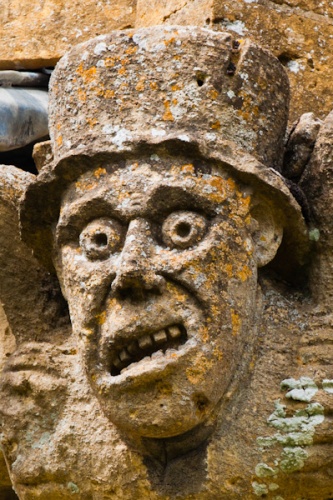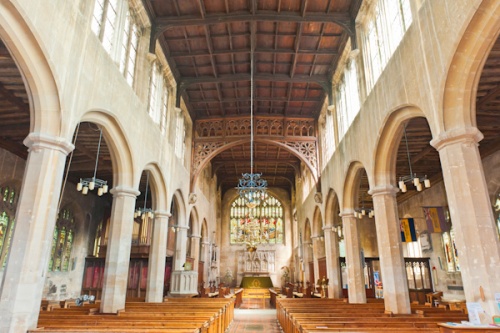
St Peter's Church in Winchcombe is one of the great wool churches in the Cotswolds, an area blessed with similar reminders of the wealth of local medieval wool merchants.
The first written record of a church dedicated to St Peter in Winchcombe comes from 1175, when a church associated with the Benedictine Abbey here is mentioned. It seems very likely that there was a much earlier Saxon church, dedicated to St Nicholas.
That Norman church gradually fell into disrepair, and in 1458 Abbot William began building a new church. The lord of Sudeley Castle, Lord Ralph Boteler, granted money to help finish the construction, and the new church was completed in just 10 years. It is an excellent example of late 15th century Perpendicular style, with a high, wide nave and large clerestory windows filling the interior with light.

OUTSIDE THE CHURCH
The exterior is dominated by a striking west tower, 90 feet high, with 8 pinnacles. Atop the tower is a gilded weathercock, brought here in 1874 from the historic church of St Mary Redcliffe in Bristol. But it is not the weathercock that most people come to Winchcombe to see, but the grotesque carvings that embellish the battlemented roofline of the exterior. (Often called gargoyles, they are technically grotesques, for they do not have water spouts passing through them as a true gargoyle does).
There are 40 of these carvings; about 20 depict demonic creatures, and the remainder appear to be caricatures of locally important people, both civic figures and Abbey officials.
To the left (west) of the south porch is a grinning figure of Sir Ralph Boteler of Sudeley, who gave money to complete the church. More famous, and beloved of postcard photographers, is a figure to the east of the porch, a grimacing human figure with a squat hat. This figure is said to be the model for the Mad Hatter in Lewis Carroll's Alice in Wonderland story.
In the south-east corner of the churchyard is a weathered preaching cross. Though it looks medieval, the cross was given by Ema Dent of Sudeley Castle in 1897 to mark Queen Victoria's Diamond Jubilee and is actually a copy of a medieval cross at Wedmore, Somerset.
If you walk around the west end of the church, towards the west tower door, you will see what appear to be pockmarks in the masonry of the north aisle wall. These are holes made by musket balls in the Civil War and tell a sad tale. Sudeley was held by Royalist sympathisers during the war, and when Parliamentary troops took the town in 1643, they executed Royalist soldiers by firing squad, standing them up against the church wall. Near the bullet holes is a medieval mason's mark.
Before you enter the church, look at the pair of black posts either side of the entrance. They are topped with small carvings of elephants, erected only a few years ago in 2009.

INSIDE THE CHURCH
Catherine of Aragon Altar Frontal
Let's start with the main reason people come to Winchcombe church! Against the north aisle wall, hidden beneath a heavy cloth curtain, is an altar cloth made from a number of 14th-century vestments stitched together.
This altar cloth is thought to have been stitched by Queen Catherine of Aragon during her stay at Sudeley Castle. If you look closely you will see her symbol, the pomegranate. The altar cloth is set within a Tudor border in fishbone style, but the inner sections of the cloth are made from vestments dated between 1380-1390. The cloth has been restored twice, once by the Royal School of Needlework.
Set into the north wall of the chancel, overlooking the altar is a beautifully painted Jacobean memorial to Sir Thomas Williams of Corndean. As is common in Jacobean memorials, Sir Thomas is shown kneeling at his prayer desk, with space on the left of the memorial for his wife - but she's not there. Lady Williams remarried, and in her will expressed the wish to be buried with her second husband. So Sir William kneels, a lonely figure, sharing his memorial with only an empty space. But it is a beautiful memorial nonetheless!
Almost facing the Williams memorial is a beautifully carved 14th-century triple sedilia, bearing the arms of Sudeley, Winchcombe Abbey, and Gloucester Abbey. There are a 13th-century piscina and aumbry (storage cupboard).
At the east end of the north aisle is the large organ. This is quite an interesting instrument; the case dates to 1735 and the central panel is thought to have been carved by the school of Grinling Gibbons (i.e. produced by his workshop, but not necessarily by the master carver himself).

Against the north wall is a wooden poorbox on a pedestal. It is thought to be 450 years old, and is sealed by three padlocks. Near the poorbox are medieval tiles salvaged from the Abbey of Winchcombe, which was destroyed at the Dissolution of the Monasteries under Henry VIII.
Hung on the wall is a 15th-century door from the abbey, with the initials RK worked into the decorative carving. The initials stand for Richard Kettering, the penultimate Abbot of Winchcombe. Almost beneath the door is a very large th century churchwarden's chest. Within this large chest, nested like those comical Russian dolls, is a still earlier oak chest dating to the 12th century and made from a single hollow log.
Flanking the west entrance to the tower, set beneath later stone arches, is a pair of Saxon coffins. These were unearthed during excavations on the site of Winchcombe Abbey in 1815 and are thought to have contained the bodies of King Kenelm of Mercia (796-821) and his son, the boy-saint, St Kenelm.
The Winchcombe Imp
The medieval rood screen dates to the late 15th century. It is beautifully carved, with fanciful foliage and scrollwork decoration. But it isn't where you'd expect to find it between the nave and chancel; it has been moved to the west end of the nave to screen off the base of the tower. Cleverly carved into the south side of the screen, half-hidden amidst scrollwork, is a small impish face, often referred to as the Winchcombe Imp. He isn't easy to spot, so take your time!

Once you have found the Imp, look back up the central nave passage and you will see a lovely 18th-century candelabrum. Dating to 1735, it was a gift to St Peter's of a churchwarden, John Merryman.
As you leave the church, look up; half-hidden in shadows over the porch door is a royal coat of arms, dated to 1778.
St Peter's church is wonderful Perpendicular building, full of historic interest inside and out. It is well worth combining a trip to Sudeley Castle with a stop in the church and a stroll about the town of Winchcombe itself.
TO SEE
- George III royal coat of arms
- 1634 font
- Saxon coffins
- 16th-century parish chest
- Floor tiles and door from Winchcombe Abbey
- 15th-century altar cloth
- 15th-century chancel screen
- 18th-century organ
- 14th-century sedilia, 13th-century aumbry, and piscina
- 40 grotesque carvings
- Civil War bullet holes
- Gilded weathercock
About Winchcombe
Address: Gloucester Street,
Winchcombe,
Cotswolds,
Gloucestershire,
England, GL54 5LU
Attraction Type: Historic Church
Location: On Gloucester Street. Nearby free parking (limited) and paid parking area within a short walk. Very limited on street parking. East walk to Sudeley Castle.
Website: Winchcombe
Location
map
OS: SP022282
Photo Credit: David Ross and Britain Express
HERITAGE
 We've 'tagged' this attraction information to help you find related historic attractions and learn more about major time periods mentioned.
We've 'tagged' this attraction information to help you find related historic attractions and learn more about major time periods mentioned.
Historic Time Periods:
Find other attractions tagged with:
14th century (Time Period) - 9th century (Time Period) - castle (Architecture) - Medieval (Time Period) - Saxon (Time Period) -
NEARBY HISTORIC ATTRACTIONS
Heritage Rated from 1- 5 (low to exceptional) on historic interest
Sudeley Castle - 0.6 miles (Historic House) ![]()
St Kenelm's Well - 1.3 miles (Historic Church) ![]()
Belas Knap - 1.8 miles (Prehistoric Site) ![]()
Stanley Pontlarge, St Michael's Church - 1.9 miles (Historic Church) ![]()
Hailes Abbey - 2 miles (Abbey) ![]()
Hailes Church, Gloucestershire - 2 miles (Historic Church) ![]()
Spoonley Wood Roman Villa - 2.1 miles (Roman Site) ![]()
Farmcote, St Faith's Church - 2.5 miles (Historic Church) ![]()
Nearest Holiday Cottages to Winchcombe:
Winchcombe, Gloucestershire
Sleeps: 6
Stay from: £449 - 2035
Winchcombe, Gloucestershire
Sleeps: 2
Stay from: £436 - 2037
Winchcombe, Gloucestershire
Sleeps: 6
Stay from: £637 - 3603
More self catering near Winchcombe















